Olfaction
Olfactory perception, also called the sense of smell or olfactory sense (from the Latin olfacere 'to smell'), is the perception of odors. The interrelationships of the complex sense of smell are explored by osmology or osphresiology.
In humans, the sense of smell often seems to play a lesser role than sight, hearing or touch. However, its performance is noticeable when olfactory perception is lost, for example, in the case of a cold.
For many wild animal species, such a condition would be life-threatening, as they are dependent on their sense of smell in several respects. For the olfactory or scent substances, which can only be perceived with this, serve to identify food, rotten food (putrefaction) or decayed food (smell of carrion), to distinguish one's own body odour from that of familiar group members (stable odour) and from that of foreign conspecifics as well as from that of other species, to warn of enemies (predator) or to suspect prey (prey animal).
Olfactory perception is therefore not only important for food intake, but also plays an essential role in social behaviour and mating behaviour. Thus, the sexual maturity of female animals is signalled to the male conspecifics by pheromones (sexual attractants). In addition, scents also serve spatial orientation. Many animals set scent marks to demarcate a territory or, like ants, follow the scent trail of predecessors. In addition, chemical signals can also be used for communication between different species. For example, the flowers of many plants emit fragrant substances that attract insects to pollinate them only (allomon) or to collect nectar only (kairomon) or to do both (synomon). In fruit-growing pest control, the effect of pheromones is used, for example, to restrict the mating of plum moths.
Various sensory systems can be involved in olfactory perception: in addition to the olfactory system itself (olfactory stimuli), the nasal-trigeminal system (tactile and chemical stimuli) as well as influences from the gustatory system (taste stimuli). The sense of smell is the most complex chemical sense. The sensory cells of smell are equipped with specific olfactory receptors and in vertebrates are usually located in the nose. Some odors are not consciously perceived (see also Jacobson organ).
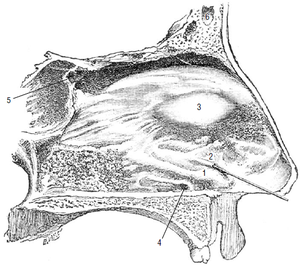
In humans, the Jacobson's organ is found as a rudiment. Illustration of a nasal cavity (sagittal section) - 1: Paraseptal cartilage, (Cartilago paraseptalis); 2: Opening to Jacobson's organ into which a probe has been advanced; 3: Tuberculum septi nasi; 4: Ductus nasopalatinus; 5: Mouth of sphenoid sinus; 6: Frontal sinus.
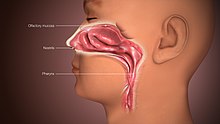
A human nose contains in its cavities the olfactory mucosa
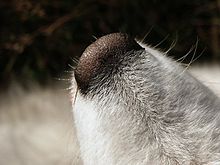
An unsnuffed dog nose, here of a Samoyed, is one of the most sensitive olfactory organs
Features in the mammals
The receptive zone of the olfactory system is located inside the nose. In each nasal cavity, three bulge-like structures project inward from the outer walls of the nose, the turbinates (conchae nasales), which direct the flow of air. The olfactory area is confined to the mucosa above the upper turbinate, the olfactory mucosa of the regio olfactoria, and is also known as the olfactory organ (organum olfactus).
This area, which is conspicuous by its yellow to brown colour and measures approximately 2 × 5 cm² in humans - 2 × 25 cm² in dogs - contains the sensory cells specialised in olfactory molecules. Specific receptors of a certain type are located in the cell membrane of extensions of the individual olfactory cells, each of which responds to particular chemical properties of the odorants. In humans, there are about 400 different molecular olfactory receptors, although a particular receptor cell usually carries only one type at a time. In dogs or rats, a total of more than 1000 different receptor types are formed.
The olfactory nerve (nervus olfactorius, I. cranial nerve) is responsible for the sensory innervation of the olfactory mucosa, while the trigeminal nerve (V. cranial nerve) sensitively innervates the remaining mucosa of the interior of the nose and can be addressed by mechanical and chemical stimuli. During normal breathing, only small amounts of partial air reach the regio olfactoria. During sensory analysis, the airflow is intensified and air is sucked in through the nose in short bursts (sniffing) or moved here from the oral cavity (tasting).
The sensory cells of the sense of smell, the olfactory cells, have a (dendritic) process from which several cilia emerge, which lie parallel to the surface in the mucus of the olfactory mucosa. Embedded in their membrane, they each carry specific receptor proteins for stimulus reception. If odorants reach these membrane proteins, they can be bound - depending on their chemical properties - and thus alter the receptor.
Via changes in the olfactory receptor proteins, subsequent activation of adenylate cyclase, subsequent activation of cAMP-gated ion channels and other steps, a receptor potential is built up and converted into a series of action potentials. These signals from the olfactory receptor cells are transmitted via their neuritic cell process to centrally located nerve cells of the olfactory system.
The axons of the olfactory cells pass in bundles of nerve fibers as fila olfactoria of the olfactory nerve through the holes of the sieve plate (lamina cribrosa) of the ethmoid bone (Os ethmoidale) into the cranial cavity to the olfactory bulb (Bulbus olfactorius) of the brain above, where central nervous processing begins. The stimulus patterns of odors are processed and analyzed in the two bulbi. The olfactory bulb is nervously linked to the hypothalamus, which is significantly involved in the control of food intake and sexual behavior, among other things.
The olfactory brain of lower vertebrates is thought to have evolved into the mammalian cortex cerebri.
The actual olfactory sensation, which may be strongly associated with emotions, memories, and hedonic judgments, then arises in rather nonspecific, evolutionarily ancient cortical brain centers. Both the chemosensory analysis of breath and the retronasal analysis of food aromas are performed in this area. Via the vomeronasal organ, which is assigned to an additional (accessory) also olfactory system, a specific olfactory or pheromone perception becomes possible. In addition, the term hematogenous olfaction is occasionally used, which refers to the perception of odorants that have been injected into the blood.
Odor-active substances must be volatile. The relationships between the chemical-physical properties of the odorants and the resulting olfactory sensations are still insufficiently researched. Most of the substances to be smelled are carbon compounds.
Olfactory perception is strongly influenced by hormonal status and motivation. For example, hypogonadism often leads to extensive anosmia (the loss of the sense of smell), high estrogen levels to increased olfactory sensitivity, or food satiety to a change in the hedonic evaluation of odors.
For olfactory perception, as for gustatory perception, a vector coding of impressions is assumed. This coding explains the extraordinary diversity of olfactory impressions and also how strongly the diversity of the perceptual world of a living being increases when only one more receptor type (about 7 instead of 6) is present and a higher resolution (about 30 instead of 10 differentiable levels) is achieved. Even between humans small differences in the resolution of the receptors have such a strong effect. In the past, humans and other primates were considered "microsmates" ("low creepers") in contrast to "macrosmates" such as dogs and rats. In the meantime, however, it is known that the olfactory performance of primates can surpass that of dogs and rats with regard to some scents. Dogs, for example, are extremely sensitive to the smell of fatty acids (prey sweat), but are less sensitive to the smell of fruit than some primates.
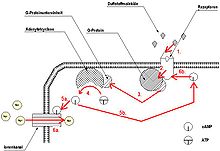
Chemoelectric triggering of excitation in olfactory sensory cells by briefly permitted ionic currents due to binding of odorant to specific olfactory receptors
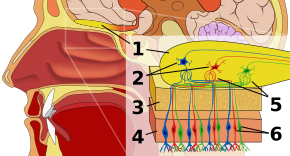
The sensory organ of the human olfactory system is the olfactory mucosa on the roof of the nasal cavities - nerve fibres reach the (secondary) afferent nerve cells located in the olfactory bulb (1, bulbus olfactorius) (2, mitral cells), nerve fibres pass through the skull bone (3, ethmoid bone) from the nasal mucosa (4, regio olfactoria) to the (primary) sensory cells (6, olfactory cells), where they form tangle-like connecting forms (5, glomeruli olfactorii).
Properties in humans
The olfactory mucosa of a human is located on the roof of the nasal cavity and has a total area of 5 cm². It contains about 20-30 million olfactory cells, which carry about 400 different receptors. A single sensory cell usually carries only one particular type of receptor. Thus, there are several thousand olfactory cells of the same type, but distributed over the entire olfactory mucosa. Odorants are recognized on the basis of chemical structural features. A single odorant usually addresses several specific receptor types and thus also different olfactory cells. Sensory cells of a specific type are excited by chemically similar compounds with the same characteristic, although the sensitivity to such classes can be quite different. By combinations of simultaneous activation of different receptors, humans can distinguish about 10,000 different odors. An alternative theory, proposed by Malcom Dyson in 1928, sees a connection with the molecular vibration of odorants. The theory was taken up by Luca Turin in 1996 and has been the subject of controversy ever since.
The sense of smell is already largely developed at birth. In humans, olfactory cells are renewed every 30 to 60 days. In the process, olfactory cells die (apoptosis) and are replaced by young new olfactory cells that have arisen from the division of basal cells. Their neurites grow out in a site-specific manner and usually move to the vacant sites in the olfactory bulb.
Stimulus intake
The 6-20 fine hairs (cilia) of the dendrite of an olfactory cell end in the mucus layer formed by Bowman's glands, which covers the olfactory mucosa. Molecules of odorants dissolve in the mucus layer and attach via specific receptor molecules in the membrane of olfactory cells. The binding of a fragrance molecule to the receptor molecule in the cell membrane of the cilia activates a G protein. This initiates a signalling cascade within the olfactory cell, whereby cAMP ensures that the Ca2+ level in the cytosol increases via the opening of (CNG) ion channels. This leads to an opening of Cl- ion channels and thus to a Cl- efflux, whereby the cell is now depolarized and an action potential is triggered.
The action potentials of the olfactory cells are transmitted as signals via their neurites to the brain. The totality of the neurites forms the olfactory filaments (fila olfactoria). This bundle of about 20 olfactory nerves (nervi olfactorii) is also considered the first cranial nerve. They pass through the holes of the sieve plate of the ethmoid bone into the interior of the skull to the bulbus olfactorius (olfactory bulb). This is where the first neuron of the olfactory pathway ends. Here lie complex interconnection points, the synapses of the olfactory bulb (glomeruli olfactorii). Here, often more than 1,000 axons, those of olfactory receptors of the same type, converge on a single downstream second neuron, which is called a mitral cell. Cells adjacent to the mitral cells (periglobular and granule cells) further increase the discriminatory power of odor sensation by signal inhibition or amplification.
In addition to connections between the two olfactory bulbs, which are already assigned to the olfactory brain (rhinencephalon) and end brain (telencephalon), there are projections to the primary olfactory cortex, the part of the cerebral cortex responsible for processing olfactory information. From there, there are also connections to other brain regions, in particular to the hypothalamus and the limbic system.
Stimulus perception can deviate during the unconscious perception of pheromones.
Perception and detection threshold
Most odor-active substances have a molar mass below 300 g/mol. For the perception of particularly odor-active substances, 10-100 million molecules are sufficient, which are 10-15 to 10-14 mol of a substance. The quantity above which a substance can be smelled is called the odour threshold. A distinction is made between the perception or absolute threshold and the detection threshold for the respective odorant (see also olfactometry).
Perception threshold
· Only four micrograms of the methyl mercaptan contained in garlic in 106 m³ of air (corresponding to a 500 × 100 × 20 metre hall), or 4-10-15 g/dm³, are sufficient to cause a person to feel that 'it smells like something'.
· Olfactory stimuli below the threshold of attention-dependent conscious perception can also develop effects as so-called subliminal stimuli, which can be used for "subliminal advertising", for example.
Detection threshold
In order to be able to recognize a certain substance by its odor, the odorant concentration must be significantly higher; for methyl mercaptan, this recognition threshold is fifty times the absolute threshold of perception and thus amounts to about 0.2 picograms per liter of air (2-10-13 g/dm³).
After all, contamination by odours can be distinguished with a simple "nose test" using olfactory strips. Even if the olfactory strip odor thresholds of people vary individually, typical threshold values can be found. Thus, 50 ppm diesel in ethanol (after training also 10 ppm), 100 ppm fusel oil (1-pentanol) in bioalcohol and 100 ppm acetic acid and (likewise) butyl acetate in acetic ester (ethyl acetate) were still "errochen". In 2018 a research paper around Veronika Schöpf, Psychology, University of Graz was published. In noses of 67 test persons, 27 typical bacterial strains occur. In people with a less sensitive sense of smell, more bacteria were found that excrete even strong-smelling butyric acid.
Many mammals have a considerably finer olfactory perception than humans - in the case of a German shepherd, for example, by a factor of 1000.
Central nervous circuits for identification and memory
In most cases, intensive experiences with the odor at a certain place or events associated with the odor play a role (episodic-autobiographical memory) for the memory capacity. The evaluation of an odor takes place before the actual odor recognition.
An implicit presemantic memory is often distinguished from a semantic memory for odors. In presemantic memory, the relation of an odor to a place is spontaneously remembered. This is often done with the help of the visual system, by picturing the place and remembering an atmosphere that we smell (for example, "Christmas"). Since there is no mapping of individual scents in the olfactory cortex, olfactory sensations are anchored with spatial association and, in the case of sighted people, are essentially also represented via parts of the visual cortex, making them pictorial. For the linguistic representation of an odour, a second, semantic reference is also required, with which a name (for example "cinnamon") can be verbally assigned and identified. In the processing of olfactory stimuli, there is thus a difference between explicit semantic and presemantic implicit memory.
Nerve fibers run from the olfactory cells in direct connection to the bulbus olfactorius, which is our primary olfactory center. Sensory olfactory discrimination occurs primarily via the projection of the bulbus olfactorius via the stria lateralis to the area praepiriformis (primary olfactory cortex) and the thalamus. This is followed by transmission to the orbitofrontal cortex. The connection via the stria medialis via the tuberculum olfactorium to the thalamus also serves odor identification.
From the olfactory bulb there are connections via the lateral stria to the area praepiriformis and further to the hippocampus. Processing in the hippocampus results in memory content being permanently stored. The hippocampus operates in a low-resource manner, meaning that it sorts out virtually no information on its way to long-term memory. For this reason, smells do not have to be learned like vocabulary, but can be stored promptly.
Central nervous circuits and emotions
The following connections primarily represent the emotional component of olfactory perception: From the olfactory bulb via the lateral stria there is a connection with the amygdala (limbic system), the lateral hypothalamus, then the basal forebrain and the orbitofrontal cortex. Similarly, there are projections via the stria medialis to the tuberculum olfactorium and on to the septum. This circuitry is primarily responsible for mediating the sensation we feel when we smell a scent. The amygdala is particularly involved in mediating feelings, and the basal forebrain and orbitofrontal cortex play a role in motivational functions. Information that is linked to emotions is easier to learn because it is not only stored explicitly in semantic memory, but is also stored implicitly with the emotional background via episodic memory.
Conditioning
In humans, some unpleasant odors can trigger protective reflexes such as gag reflexes. The close connection of the sense of smell with the limbic system and the hypothalamus leads to a special position in learning processes: Unlike classical conditioning, the time intervals between unconditioned stimulus and conditioned stimulus can be extremely extended. Despite long intervals, a conditioned reaction (for example, nausea and vomiting as a result of disgust) can thus occur, triggered by an originally neutral stimulus (for example, a certain odor), which now causes this reaction as a conditioned stimulus.
The hedonic evaluation of odorants, in contrast to taste, is largely learned in humans during the first 5-10 years of life. While newborns show clear pleasure or displeasure reactions to sucrose (sweet) or caffeine (bitter) stimuli through mimic reactions, the reactions to odours are often indifferent. The smell of faeces, fruit or sweat is hedonically little differentiated.
Perceptual disorder
A distinction is made between quantitative and qualitative olfactory disorders. The quantitative disorders include the complete absence of the sense of smell as anosmia, the too low olfactory performance as hyposmia and the excessive olfactory performance as hyperosmia. Qualitatively disturbed smelling is cacosmia or parosmia in the neurological field and phantosmia as an olfactory hallucination in the psychiatric field.
Linguistic expression
Humans are estimated to be able to distinguish over 1 trillion different mixtures of odorants. However, the lack of linguistic expressions for odors limits our ability to communicate olfactory nuances in a differentiated manner. While untrained people recognize and correctly name about 50 % of repeatedly presented odors, trained people can increase their hit rate to 98 %. Unlike other sensory impressions such as colour names as part of visual perception, there are no abstract basic concepts in olfactory perception. In various proposals of systematization and classification, the basic odors are oriented to the material designations.
→ Main article: Smell
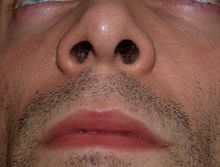
Nostrils (Photo: David Shankbone)
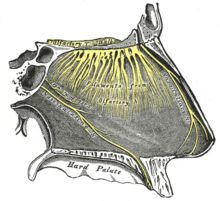
Sagittal section through the nasal cavity of humans
Questions and Answers
Q: What is olfaction?
A: Olfaction is the sense of smell.
Q: How do humans and animals notice a smell?
A: Humans and animals notice a smell by using their nose.
Q: Do animals have a better sense of smell than people?
A: Yes, many animals have better noses than people.
Q: What special cells in the nose can detect some chemicals?
A: Special nerve cells attached to the olfactory epithelium can detect some chemicals.
Q: Do all vertebrates have these special cells in the nose?
A: Yes, all vertebrates have these cells.
Q: Where is the smell first processed in humans and animals?
A: The smell is first processed by the olfactory system.
Q: In insects, where are smells sensed?
A: In insects, smells are sensed by sensillum on the antennae.
Search within the encyclopedia